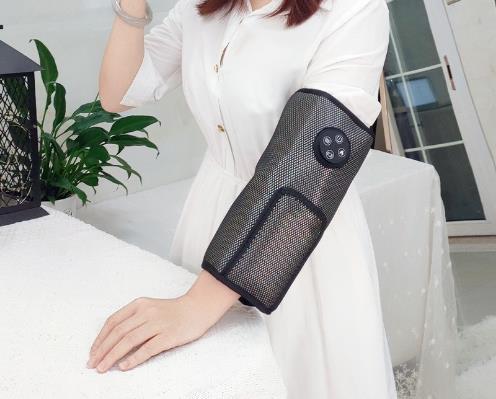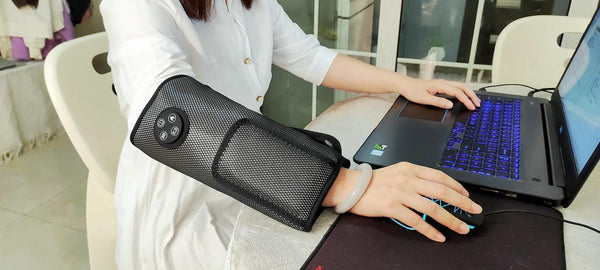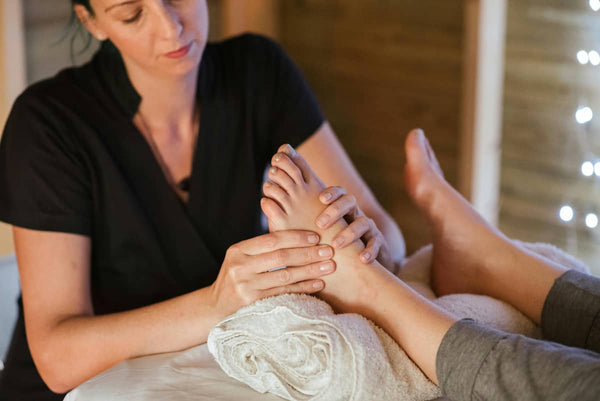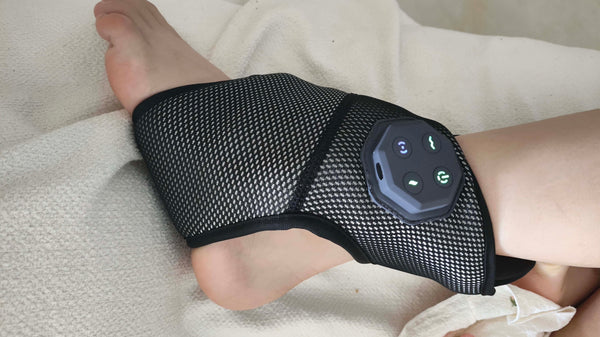 Are you tired of that sinking feeling when you reach for your beloved electric massager after a long day, only to find its battery stubbornly dead? It’s a common frustration, especially for us middle-aged and elderly fitness enthusiasts who rely on these amazing devices for post-workout recovery or daily aches. This "charging anxiety" is real, and it often dictates our choice between cordless freedom and continuous power. This electric massager has become indispensable for many, turning into a source of comfort, but also, for some, a hidden source of anxiety. Did you know that despite these worries, rechargeable foot massagers still account for a whopping 68% of Amazon sales? It seems convenience often wins the day, but at what cost to our peace of mind?
Are you tired of that sinking feeling when you reach for your beloved electric massager after a long day, only to find its battery stubbornly dead? It’s a common frustration, especially for us middle-aged and elderly fitness enthusiasts who rely on these amazing devices for post-workout recovery or daily aches. This "charging anxiety" is real, and it often dictates our choice between cordless freedom and continuous power. This electric massager has become indispensable for many, turning into a source of comfort, but also, for some, a hidden source of anxiety. Did you know that despite these worries, rechargeable foot massagers still account for a whopping 68% of Amazon sales? It seems convenience often wins the day, but at what cost to our peace of mind?
Stopping the Drain: Pain Point Verbing in Your Portable Massager Routine
As a physiotherapist, I've heard countless tales of woe: "My new electric massager barely lasts two sessions!" or "Why did I buy a portable massager if I have to charge it everyday?" It's a genuine problem, and it often stems from products that overstate their capabilities. For instance, some users report Ryoku’s actual battery life of massager is a frustrating 30% shorter than claimed. This overstatement turns your otherwise valuable portable massager into a daily chore, forcing you to constantly eye the power outlet rather than enjoying your relaxation. It’s certainly a buzzkill when you expect freedom but get a leash instead!
But don't despair! Not all portable massagers are created equal. We're seeing fantastic advancements in quality batteries for massagers. Take Klcosy, for example. Users rave about their devices, which come with a verified 5000mAh battery and a super safe 5V2A low voltage. This isn't just jargon; it means these electric massagers can genuinely support over five full massage sessions on a single charge. Prioritizing actual, verified battery life of massager is paramount for satisfaction. This ensures consistent performance and a truly great battery life of massager, allowing you to actually relax without constantly eyeing the power outlet.
Corded vs. Cordless: Stable Power or Portable Massager Freedom of Choice?
This is the age-old debate in the world of electric massagers: do you crave the unwavering, consistent power of a plug-in model, or the unbridled flexibility of a portable massager? Plug-in foot massagers offer stable power, sure, but they tether you to a wall. Imagine trying to use one while lounging on the patio or, heaven forbid, during international travel where different outlets and baggage check issues become a real headache. This choice significantly impacts how you use your electric massager, limiting its reach and versatility to fixed locations.
On the flip side, portable massagers, while offering amazing freedom, do require downtime for charging. It’s a trade-off, isn't it? However, as I mentioned, the sheer volume of rechargeable foot massager sales on Amazon (68%!) proves that for most people, the ability to use their device anywhere and anytime, from the living room couch to a hotel bed, often outweighs the minor inconvenience of occasional charging. Ultimately, a portable massager offers freedom that a plug-in simply cannot match, empowering your relaxation wherever you may be.
Battling Degradation: Quality Batteries for Massager Demands Vigilance
 Here’s a truth bomb about electric massagers that many manufacturers conveniently overlook: the battery's lifespan. Poor-quality batteries can be a real short-changer, boasting a cycle life of only 200 charges. Compare that to the industry average of 500 charges, and you quickly realize you're getting half the value. This isn’t just about inconvenience; it means significant battery degradation after just six months, turning your once-powerful portable massager into a feeble vibrating toy. It's disheartening to see a powerful electric massager quickly lose its vigor.
Here’s a truth bomb about electric massagers that many manufacturers conveniently overlook: the battery's lifespan. Poor-quality batteries can be a real short-changer, boasting a cycle life of only 200 charges. Compare that to the industry average of 500 charges, and you quickly realize you're getting half the value. This isn’t just about inconvenience; it means significant battery degradation after just six months, turning your once-powerful portable massager into a feeble vibrating toy. It's disheartening to see a powerful electric massager quickly lose its vigor.
So, how do we protect ourselves from this quick decline in battery life of massager? It truly requires long-term user validation. Before committing, ask yourself: does this company have a reputation for using quality batteries for massager? Do they offer transparency about their source factories? Identifying manufacturers with robust quality guarantees is key. For example, look for certifications or independent reviews that specifically mention long-term battery performance. A robust portable massager should have quality batteries for massager that align with industry standards, ensuring it remains a true investment in your well-being, going the distance rather than dying out quickly.
Choosing Your Champion: A Solution-First Guide to Electric Massagers
Deciding between a cordless marvel and a plug-in workhorse, or even identifying a truly reliable portable massager, can feel overwhelming. Let’s break it down to help you pick the best electric massager for your needs, ensuring you eliminate that charging anxiety for good. The journey to finding your ideal electric massager is about understanding your unique needs and making an informed choice. This isn't just about features; it's about matching the device to your lifestyle and ensuring long-term satisfaction.
| Feature | High-Quality Rechargeable Portable Massager | Lower-Quality Rechargeable Portable Massager | Plug-in Electric Massager |
|---|---|---|---|
| Portability | Excellent – truly mobile, fits diverse scenarios. | Good initially, but limited by short battery life of massager. | Limited – tethered to power outlet. |
| Power Stability | Consistent power throughout battery cycle. | May lose power as battery depletes. | Unwavering, continuous power. |
| Charging Downtime | Minimal (e.g., charge overnight for multiple sessions). | Frequent, disruptive charging needed. | None – always ready when plugged in. |
| Battery Life (Initial) | Excellent (e.g., Klcosy: 5+ sessions on 5000mAh). | Poor (e.g., Ryoku: 30% shorter than claimed). | N/A (no internal battery). |
| Battery Degradation | Slow, expected over years (500+ cycles from quality batteries for massager). | Rapid, significant after 6 months (200 cycles). | N/A. |
| Usage Scenarios | Home, office, travel, outdoors. Highly versatile. | Primarily home use, less flexible due to short life. | Primarily home/office, fixed locations. |
| Travel Friendliness | Excellent – compact, no cord issues. | Fair – still portable massager, but unreliable charge. | Poor – cord limitations, international voltage/plug concerns. |
| Long-Term Value | High – durable, reliable, worth the investment. | Low – becomes a burden quickly. | High – consistent performance over time. |
Navigating Your Needs: How to Choose an Electric Massager Without Regret?
As your friendly physiotherapist, I truly want you to find an electric massager that brings you joy, not frustration. So, how do you make the right choice, especially when navigating the tricky waters of battery life of massager and battery quality? It’s about asking yourself the right questions and looking beyond the flashy advertisements. The promise of a truly portable massager is fantastic, but only if its battery holds up. Remember, your comfort and long-term satisfaction are paramount!
Here’s a quick self-assessment flow to guide your decision:
- Are you a nomad or a homebody? If you dream of relief anywhere, a portable massager is your best bet. But if your massage sanctuary is always at home, a plug-in model offers unwavering reliability.
- How long do you need power to last? For quick 15-minute bursts, even a lower-quality rechargeable might suffice, but for prolonged sessions or multiple uses between charges, you absolutely need quality batteries for massager. The central role of battery life of massager cannot be overstated.
- Is long-term value important? If you want your electric massager to be a trusted companion for years, prioritize brands known for their durable batteries (500+ charge cycles) and solid warranties. Don't compromise on quality batteries for massager for a lower upfront cost. This means investing in the long-term battery life of massager.
When selecting your specific model, always consider these crucial criteria:
- Verify the Battery Life of Massager: Don't just trust marketing claims. Look for independent reviews, user testimonials, and a clear specifications. A verified 5000mAh battery for a portable massager is a great starting point.
- Check Battery Specs: Look for not just capacity (mAh) but also voltage (e.g., 5V2A for safe, efficient charging). This is a direct indicator of quality batteries for massager.
- Brand Reputation & Guarantees: Does the brand stand behind its products? Can you identify if they source from reputable factories known for quality batteries for massager? This helps avoid the disappointment of rapid degradation.
- Read User Reviews (the long-term ones!): Pay attention to reviews from users who have had the product for several months or a year. Do they still praise the battery life of massager? Or do they complain about it dying quickly? This is your most honest feedback. Ensure your new electric massager is a long-term asset, not a short-term fling.
Beyond the Buzz: Are Electric Massagers Safe and Can They Cause Issues?
As a physiotherapist, the safety of any therapeutic tool is always my top concern. So, let’s address the elephant in the room: Are electric massagers safe, and can they cause issues? Generally, yes, they are safe when used correctly! An electric massager can be a fantastic tool for muscle relaxation and pain relief when applied thoughtfully. However, like any tool, misuse or ignoring contraindications can exacerbating issues. Always remember, these are assistive devices, not miracle cures.
For most healthy individuals, an electric massager is absolutely safe. They can effectively relieve muscle tension, improve circulation, and reduce pain. The low voltage of devices like the 5V2A Klcosy examples you see ensures electrical safety during use. However, misusing any electric massager, even one with the best quality batteries for massager, can lead to problems. For instance, applying too much pressure directly over bony areas, varicose veins, or inflamed joints can exacerbate pain. They are not recommended for areas with open wounds, severe swelling, skin infections, or for individuals with certain medical conditions like deep vein thrombosis, severe osteoporosis, or those using pacemakers (unless cleared by a doctor). If you have underlying health issues, always consult your physician or physiotherapist before integrating an electric massager into your routine. Overuse can also lead to muscle soreness, just like overdoing any exercise. Listen to your body!
Your Path to Bliss: How to Choose the Right Electric Massager for You?
Choosing the right electric massager for you isn't just about picking a device; it's about investing in your daily comfort and long-term well-being. Think of it as a crucial step towards a more relaxed, less achy you! Whether you prioritize boundless portability or steadfast, plug-in power, the key lies in informed decision-making. Don't let charging anxiety dictate your comfort; take control! The right electric massager can significantly enhance your quality of life.
In conclusion, the debate between rechargeable and plug-in foot massagers, and the critical role of quality batteries for massager, boils down to your individual needs and how you value convenience versus continuous power. By understanding the nuances of battery life of massager, looking for reliable specifications like 5000mAh capacity, and being wary of exaggerated claims, you can truly eliminate charging anxiety. Remember, a well-chosen electric massager is a cornerstone of quality of life, allowing you to move freely and comfortably. So, go ahead, invest in your well-being!
Ready to banish charging anxiety and embrace blissful relief? Explore portable massager models with verified quality batteries for massager, or choose a steadfast plug-in for uninterrupted relaxation. Your feet (and your peace of mind) will thank you!




0 comments